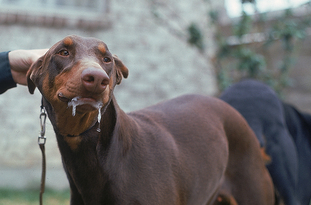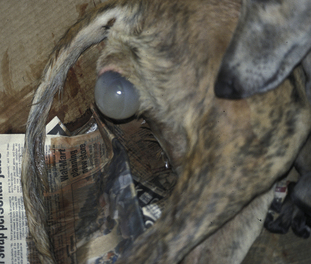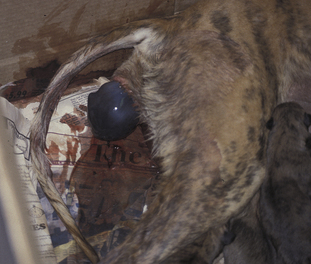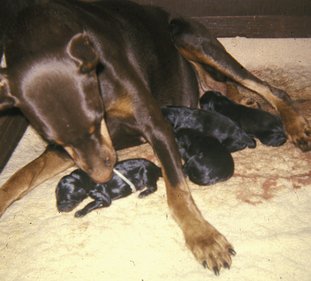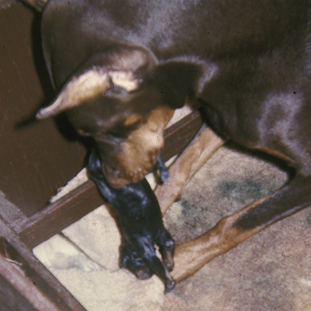CHAPTER 6 Female Canine Sexual Behavior
Reproductive behaviors of a female dog are not generally understood by the public. A survey of owners relinquishing their dog to an animal shelter revealed that 43% of them did not realize a dog would have two estrous cycles per year.136 In addition, 61% either believed or were not sure if a bitch was better off having at least one litter before she had an ovariohysterectomy.136 Because 59.7% of the dogs relinquished were acquired at no cost,136 and because they are less likely to have been neutered,110 it suggests many dog owners do not want to invest in their dog. It is important for veterinarians to educate new dog owners about good care, especially relative to reproduction.
PRENATAL INFLUENCES
Differences between male and female dogs become most obvious after puberty, but subtle differences can be detected even in the very young. As mentioned in the last chapter, the brain must be exposed to a testosterone surge around the time of birth for male characteristics to develop. Without that exposure, the brain develops as a female.78,80 If female puppies are given testosterone before or just after birth and tested as adults against normal males and females, the results suggest a definite shift toward maleness.12,15,16 Conversely, male puppies deprived of the perinatal testosterone show a definite shift toward femaleness.78 This early influence on the infant brain determines what adult sexual behavior will emerge when the gonadal hormones are activated at puberty.
Hormones can influence developing fetuses in another way. It has been shown in several species that typically give birth to multiple offspring in each pregnancy that female fetuses positioned near a male fetus,47,114 and being “upstream” in the uterine blood flow, have increased chances of contacting androgens from male fetuses.96,133,161,162 This can help explain the gradual progression between male and female in behavior, as well as appearance, in sexual dimorphism. Obviously surgical neutering affects this too.
Other than reproductive behaviors, three traits have been described as sexually dimorphic for the female dog—ease of training, tendency to seek more attention, and the ease of housebreaking.87
SEXUAL MATURATION
Sexual maturation can actually take place over a wide age range—from 1.5 to 24 months.20,68,143 The most common age for puberty is 6 to 9 months.22,65 In one study, however, the average age of first estrus was 42.4 days (± 15.7).143 Considerable breed variation exists in regard to puberty, but it usually occurs in dogs considerably earlier than it does in the wolf, for which the first estrus is around 22 months of age.32 The age of onset of first estrus in dogs is 7.8% heritable.143 Occasionally the first proestrus signs may end abruptly without leading to a standing estrus. This cessation of signs is usually followed in 2 to 3 months by the first complete proestrus-estrus-metestrus series.20,70 The earlier partial sequence probably indicates follicular activity without ovulation accompanied by corresponding hormonal insufficiencies.167
Various features of the first complete estrous period differ from those of the second and subsequent ones. Not only are serum hormone concentrations lower during the first cycle, but the durations of proestrus and estrus are shorter.39 In breeding colonies, it has been determined that the optimal breeding age for a dog is 2 to 3.5 years.100 At this age a bitch can wean the most puppies/litter (average of 4.28 puppies) with the lowest puppy mortality (8.5%).100 For bitches 7 years of age, weaned litter size is 1.22 puppies, and mortality approaches 40%. For those 9 years of age, 0.6 puppies/litter are weaned, and mortality is almost 80%.100
REPRODUCTIVE CYCLES
The idea of a reproductive cycle occurring every 6 months is a misconception. In fact, there are more exceptions to the “normal” cycle than a general statement will allow. The estrous cycle of the bitch is unique among domestic animals because every phase is prolonged.98 The bitch has between one and three estrous periods each year.20,51,159 Although an average estrous cycle is said to last 6 months, the actual duration can vary between 4 and 12 months.22 No evidence of a seasonal nature to the estrous cycle in dogs exists overall,99,143,146,152 but certain breeds might have a slight tendency to be in estrus in early fall69 or late winter–early spring.44,99,152,158 In contrast, wolves and most other wild canids are seasonal breeders, with a single estrous period in early spring.20,32,102 Evidence also suggests that some estrous synchronization occurs in bitches housed together.65
The duration of proestrus, estrus, and vaginal bleeding is the same across various breeds, ages, and mated versus unmated bitches.26 Proestrus can last 1 to 27 days but typically lasts 5 to 10 days.20,26 External signs include vulvular swelling and a bloody discharge, plus an unwillingness to stand for mounting. Estrus has a mean duration of 9 to 13 days, with a range of 4 to 24 days.20,26,45,89,126 Vaginal bleeding continues from proestrus until day 9 of estrus, although in an occasional dog it might continue into metestrus.26 It is felt that the combined duration of a normal proestrus and estrus should not exceed 21 days.153
Metestrus lasts 80 to 140 days and initially may include a dark vaginal discharge.20,99 Although the entire estrous cycle ranges from 4 to 12 months, it averages 218 days in laboratory Beagles.43,143 The length of the cycle was only 43% repeatable in bitches, but heritability of when estrus recurred was relatively high, at 38%.143 Significant differences exist in the length of the entire estrous cycle across various breeds; however, these differences are unrelated to the average size or weight of breed members.44 In one study of seven breeds, German Shepherds had the shortest interestrous interval—149 ± 28.5 days.146 Another study indicated metestrus varies by breed, but not by size.99
Vaginal Smears
Much has been written about being able to follow an estrous cycle noninvasively by using vaginal smears.* Changes in the vaginal epithelium, and thus in the vaginal smears, are caused by hormonal changes associated with ovarian and pituitary activity. The behaviors associated with the estrous cycle also are related to the hormonal changes, but more variation occurs in behavioral sequences than in vaginal cytology. Thus, vaginal smears are a more accurate method of determining hormonal activity than are behavioral measurements, body temperature changes,43 or body weight fluctuations.27
MATING BEHAVIORS
Proestrous Behaviors
Proestrus is characterized by rapid follicular development and an increase in estrogen. These changes result in swelling of the vulva, congestion of the reproductive tract, and a bloody vaginal discharge.126,165 The behavior of the bitch becomes increasingly restless as she falls under estrogen’s influence, and behaviors gradually approach those of standing estrus.46 The female will begin to play bow and show submissive behavior toward the male.93 As ovulation approaches, the female will show an increased frequency of urination, more licking of the vulva, and a greater attraction to males, and she will spend more time with nearby males.20,66 More time is spent investigating male dogs and their urine as compared with time spent investigating female dogs and female dog urine.57 When first approached, the female will usually stand quietly while the male smells her but crouch down if he attempts to mount.22 When in proestrus, a bitch may even show aggression toward the male.22,153
Estrous Behaviors
The behaviors of estrus include all aspects of courtship, mating, and postmating rituals. Initial mate selection can be more than a random act of mating with whichever male happens to be nearby. During their first estrus, females tend not to show active courtship solicitation, although they may identify preferred mates.74 Variations in behavior are more likely to occur during the first estrus period than in subsequent ones.167 These behavioral variations are probably related to hormonal insufficiencies or irregularities.51,167 Only 10% of females will actively avoid or attack specific males during the first estrus.74 Most older females show some amount of preference for certain males.* The preferences and aversions shown by individual estrous bitches may be different than the social affinity between the same dogs when the female is anestrus.10 Preferences tend to persist from one estrus to the next.10 If housed away from males, an estrous female seldom rejects a male.44 Favored males often were raised around or lived with the female.10,53 During the first heat, the female does not let a littermate sniff, lick, or mount her unless he persists more than 30 minutes.74 By the second estrus, she may reject half the males that were accepted during the first heat, but there are usually twice as many males around.74 She will not allow unfamiliar males to mate with her.53
The relative dominance between the dogs can influence whether a successful mating will occur. A dominant female may not let a subordinate male mount.64 Conversely, a dominant male may be shown extremely submissive postures by a subordinate female, or he may inhibit a submissive male from mating merely by being present.64
Premating behaviors include seeking out males and increased vocalization, restlessness, and exploration. By the time of estrus, the bitch is usually being followed by two to eight males.74 The rate of scent marking by the bitch in the presence of a male, which may include a leg-lift urination posture,80 will at least double.74 Overmarking by the male also increases.109 The time spent searching for food decreases, interest in male urine and anal sac odors increases, and 70% to 80% of her time is spent with potential partners.56,74 If only one or two males are present, a bitch may show soliciting behavior. This behavior includes physical contact with the male, and if there is no response, the bitch will present the perineum with the tail up to the male’s nose. That behavior is often sufficient to induce the male courtship behaviors. If the male shows interest, the female may run a short distance away. If the male shows minimal interest, the bitch may continue the teasing behavior by sniffing and licking the male’s anogenital area and by investigating his face, inguinal area, and penis. She may mount the male, and although this generally is a strong soliciting behavior, it may take between 2 and 29 mounts before the male responds by mounting or leaving.74
By definition, estrus is the time when the bitch will stand for the male, although this behavior is strongly influenced by the hormonal state and environmental factors. The female also shows more interest in odors associated with male dogs when she is in estrus.57 The word estrus is said to come from oistros, which means “mad desire.”66 Preferences may be displayed for certain familiar males, and rejection of others can also occur.9,10,17,53 Over half of males are unsuccessful.51 While the male mounts, the bitch stands quietly with her tail flagged to one side.79 Once the tie occurs and the male dismounts, the bitch may remain standing quietly, pull against the tie, or forcefully throw the male off balance.20 This twisting and turning usually lasts 5 to 30 seconds, and the female may actually roll over once or twice.78 Studies suggest the twisting and turning reaction is a spinal reflex evoked by clitoral stimulation.78 Excessive salivation may also be seen, in which saliva comes out of the corners of her mouth (Fig. 6-1).20 Unlike males, most females will tie at least once during their first year.74 Should the mount not result in a long tie, the estrous female will become very active and sexually aggressive toward the male.11,70 She will bump him, investigate his inguinal and perineal areas, mount him, and present her perineum to him. She may mate once or twice daily for 2 to 5 days.103
Female dogs will mount other females more often when the mounted animal is in estrus, but the frequency is not related to the hormonal state of the one doing the mounting.19,46 When a female mounts a male, the female usually is in estrus.19
Odor
Odors are significant communication signals for canids. Sexually experienced males spend more time investigating estrous urine and vaginal secretions than diestrous urine, male urine, vaginal secretions, or anal sac odors.13,56 Volatile compounds in urine from an estrous bitch are different from those in an anestrous one. The active principle has been identified as methyl-p-hydroxybenzoate.1,75,76,109 Other major constituents are methyl propylsulfide, methyl butylsulfide, and acetone.137 Both of the sulfides are somewhat higher during proestrus and estrus than during metestrus or anestrus.137
Metestrous Behaviors
During metestrus, the bitch again is unreceptive to the male. Because this is the time the corpus lutea are maintained, maximal plasma progesterone levels occur. A gradual decline in progesterone then follows over the 50- to 60-day period.45 Estrous females may be attractive to metestrous females, resulting in mounting by the metestrous individuals.45
Other Species
Many canids are close genetically, which allows for opportunities of crossbreeding. Crossbreeding can occur by artificial breeding or if the dog and wild species member are tolerant of each other’s species, usually through socialization. Dog crossbreeding with wolves, coyotes, and jackals will produce fertile offspring, but dog crossbreeding with foxes will not.71
In canids of all species, including the domestic dog, large females produce young that are larger than those of small females.23 Relative to the mother’s own body weight, though, large females allocate fewer resources to bringing a large pup to term.23
PREGNANCY
At birth a female puppy has approximately 700,000 ova.126 This number decreases to 250,000 at puberty, 33,000 at 5 years of age, and 500 at 10 years.126 These figures reflect the decreasing fertility rates and litter sizes that occur with age, too. It has been shown that successful pregnancy is related to many things. Ovulation usually occurs 1 to 2 days after the bitch will stand for breeding.88 By the end of estrus, histologic evaluations indicate that 93.5% of ovarian follicles have ruptured.164 Breeding success for the species as a whole occurs because each bitch has two or three estrous cycles a year and a generally good conception rate. The probability of pregnancy is helped both by the release of most eggs and by a typical intrauterine life span for sperm of 48 ± 12 hours and a maximum possible of 6 days.48,138 It can be argued that the normal reproductive state of a female dog is being pregnant or caring for puppies.
Once ovulation occurs, the corpus luteum reaches maximum size in 4 to 8 days, approximately 7 days before fetal implantation, and remains visible on the ovarian surface for 16 weeks.22,88,165 The high progesterone levels from the corpus luteum maintain pregnancy for 51 to 80 days, with the average length of time being 62 to 65 days.48,117,124,151 Normally, there is a sharp fall in progesterone 36 to 48 hours postpartum, suggesting a role for decreasing progesterone levels in parturition.49 Onset of parturition is partially affected by litter size, as well as by length of pregnancy and hormonal state.48,117 Because the corpus luteum remains regardless of whether pregnancy occurs, false pregnancies might be considered normal. Because they are considered abnormal to most dog owners, however, they will be discussed under the “Female Sexual Behavior Problems” section of this chapter.
As the end of a normal pregnancy approaches, the bitch begins to show external signs, including behavior changes. She will seek a quiet area with some type of appropriate nesting material. An instinctive tendency to dig is present, inherited from canine ancestors that dig their own nest sites.117 As the female’s restlessness increases, she will frequently rearrange bedding material, especially in the days immediately before parturition. The bitch’s appetite will decrease during this time as well.30
In the 12 to 24 hours before the actual onset of labor, there is a dramatic increase in restlessness.30 The bitch will shred nesting material by digging and tearing it. She will get up and lie down, ask to go in and out (in the case of a house dog), and posture as if for urination. She will show an increased friendliness toward favored individuals but an increased aggression toward strangers, which is probably a remnant behavior of protecting the nest site.30 Dogs that are extremely attached to their owners may become distressed if the person leaves the area of the nest site.117 For these dogs, the stress of separation may be so great as to cause them to leave a chosen site and whelp near the owner instead.
Parturition
The Contraction Phase
Parturition is divided into four phases and is similar to that of other multiparous mammals. As the birth of each puppy becomes imminent, the bitch will show a specific series of behaviors that last 1 to 10 minutes. These are the external signs of the first phase—the contraction phase.22 Activity decreases, with the bitch spending more time sitting or lying on her side, perhaps with her back pressed against something firm.30,117 She may also seek out a nest site, although this may have been done already in the preceding few days. Respirations increase to 100 to 175 breaths per minute for periods lasting from a few seconds to longer than a minute.30 These increased respiratory rates alternate with normal rates of 16 to 20 breaths per minute and an intermediate rate of 40 to 60 breaths per minute,30 and are probably related to times of active uterine contractions. At least in some animals, these contractions help position the fetus for delivery. The cervix dilates during this phase for the first puppy. The contraction phase may be very brief or as long as 36 hours in a nervous bitch67 but typically lasts 6 to 12 hours.91
The Emergence Phase
In the emergence phase, the bitch may shiver, have occasional twitching of the rear limbs, and with a few strong uterine contractions, push the puppy into the birth canal. Externally, a bulge appears just above the vulva as the fetus nears its exit (Fig. 6-2). The chorioallantois will begin to protrude from the vulva and often breaks to release its watery contents.22 The emergence phase usually lasts a few seconds, but if it is prolonged, the bitch may start removing the fetal membranes before the puppy is completely out.30
Delivery
Uterine contractions and forceful straining of abdominal muscles result in expulsion of the puppy (Fig. 6-3). This is the delivery, or third, phase of parturition. The mother’s attention is immediately given to licking up fetal fluids on the puppy, herself, and the nest material.83 In so doing, she cleans up the puppy, removes remaining amnionic membranes, and stimulates the first respirations in the newborn. The bitch will chew through the umbilical cord and eat the fetal membranes (Fig. 6-4). Some authors combine the emergence and delivery phases into one—that of expelling the fetus.67,83,117
The Placental Phase
Eventually the alternating periods of rest and puppy-oriented attention give way to the placental, or fourth, phase. Uterine contractions resume and result in the expulsion of the placenta. Bitches normally eat the placenta after its delivery. Even though this behavior is not necessary in dogs, eating of fetal membranes probably serves specific purposes in wild canids. First, it provides a source of protein to the mother—necessary because she uses up a considerable amount of energy in parturition,30 and she will not be able to hunt for several days. Second, it removes the tissue from the nest site so it does not become an attractant for potential predators. Removal of the membranes also helps with sanitation to minimize the risk of infection.30 Perhaps it helps eliminate some thirst for the new mother, too.30 What actually triggers the behavior in canids remains unknown, but perhaps it is an odor.30
In multiparous animals like dogs, multiple births can mean that a second, or even third puppy could be delivered before the first one’s placenta is expelled, and this is more likely to occur if the puppies have been carried in opposite uterine horns.67 When a puppy is expelled from one uterine horn, the next puppy will come from the opposite horn 78.2% of the time.156 And then, one, two, or even three placentas may come at one time. Thus, the phases of parturition associated with the delivery of more than one puppy may overlap in their sequencing. Once a puppy has been born, the bitch’s attention may be directed toward removal of fetal fluids from the nest site, even to the point of ignoring the new arrivals.
In uncomplicated births, the time for delivery of four to five puppies averages 3.0 to 3.5 hours, with irregular delivery intervals of 10 to 60 minutes between births. Giving birth to 11 puppies can take 2 to 15 hours, with an average of about 9 hours.117 Review of registration records indicates the average litter size is 4.73 puppies, with a sex ratio of 1.024 male puppies to 1.0 female.130 Small dogs like Papillons, Norwich Terriers, English Toy Spaniels, Brussels Griffins, and Pomeranians have the smallest litters.152 And, as might be expected, the bigger dogs have the largest average litter size, including English Foxhounds, Irish Setters, Irish Water Spaniels, and Golden Retrievers.152 They also have a greater percentage of male puppies.152 Free-ranging dogs are influenced by a broader range of genetic influences. Their average litter size is 5.83 puppies with 1.69 male puppies to 1.0 females.124
During parturition, the bitch is insensitive to the distress calls of the neonates30 but she is sensitive to other disturbances. It is not until after all the puppies are born that the bitch begins responding to the puppy cries.22,30,67,70,117 If a single disturbance occurs during a time with no to minimal uterine contractions, either contractions do not begin, or else a fetus is not expelled at the next expected interval.30 If the disturbance occurs during labor, the puppy may not be expelled, and one or more ineffective bouts of uterine contractions will follow.30 Long disturbances are disruptive to the birthing process. In addition to stopping labor, the bitch often shows aggression, agitation, and apprehension.30 Disturbance also increases the likelihood that she may injure one or more of her newborn puppies. Parturition resumes in 15 to 60 minutes after a disturbance unless there are repeated disturbances. Such disturbances can result in delays as long as 6 hours, even with a puppy already in the birth canal.30 Strong but ineffective uterine contractions may be accompanied by vigorous grooming of puppies, as if the behavior were being directed at a phantom newborn.30
Bitches will usually treat puppies that are born dead the same as those born alive until their bodies cool.30 Then the bitch may push away the lifeless body, eat it, or bury it.30,117
Puppies are influenced by the dam in more ways than genetics. At birth, puppies from large litters will weigh less than those from small litters, but during the next several weeks things will change. Those born to a bitch during her first 1.5 years will weigh 25% more at weaning than those born during the following 4.5 years.169 Puppy weight does affect behavior and ability to thrive. Large female puppies are more active and explore more. They will score higher on defense drive and hardiness as adults, too.169
MATERNAL BEHAVIOR
Maternal-Young Interactions
During the first 12 hours after the completion of parturition, the new mother rarely leaves the puppies and she is extremely protective of them, especially toward strangers.30 This extreme reaction may be a way to release her inhibition—that is, the prey-like appearance of the puppies and her hormonal state would normally trigger aggression, but this aggressive instinct is inhibited. She may let familiar people handle her puppies, but even then the bitch remains nervous until the puppies are replaced.100 Removed puppies are licked more than those left alone.129
During the first week, the bitch hardly leaves the puppies. By 2 weeks postpartum, she will remain outside the nest box for 2 to 3 hours at a time.70 When in the box, the new mother grooms the puppies frequently and nurses them often. Puppies will spend a maximum of 27.54 minutes per nursing bout during the first week.124 She will also rest with the puppies, a behavior that helps her offspring maintain body temperature when they are incapable of doing so on their own.
During the first few weeks, the bitch is relatively insistent that the puppies remain where they were whelped. She will take the puppy away from someone who picks it up, or she will retrieve the entire litter from a new location if they have been moved.30,70 She may not retrieve an individual puppy that has wandered off on its own even if it uses distress cries. For most puppies, that is not a problem because the owners are more than willing to retrieve a wanderer.
Some newborns do not thrive. A bitch may reject such a puppy because of its low body temperature, lack of movement, or some other reason that is not clear to us.60 This rejection may be expressed by ignoring the puppy, shoving it out of the nest box, killing it, or burying it away from the nest box (Fig. 6-5). Such behavior can be very upsetting to owners, but in nature it would minimize the attraction of predators to the other youngsters and avoid wasting precious energy resources of the mother on a neonate that would probably not have a good chance for long-term survival.
< div class='tao-gold-member'>
Stay updated, free articles. Join our Telegram channel

Full access? Get Clinical Tree


